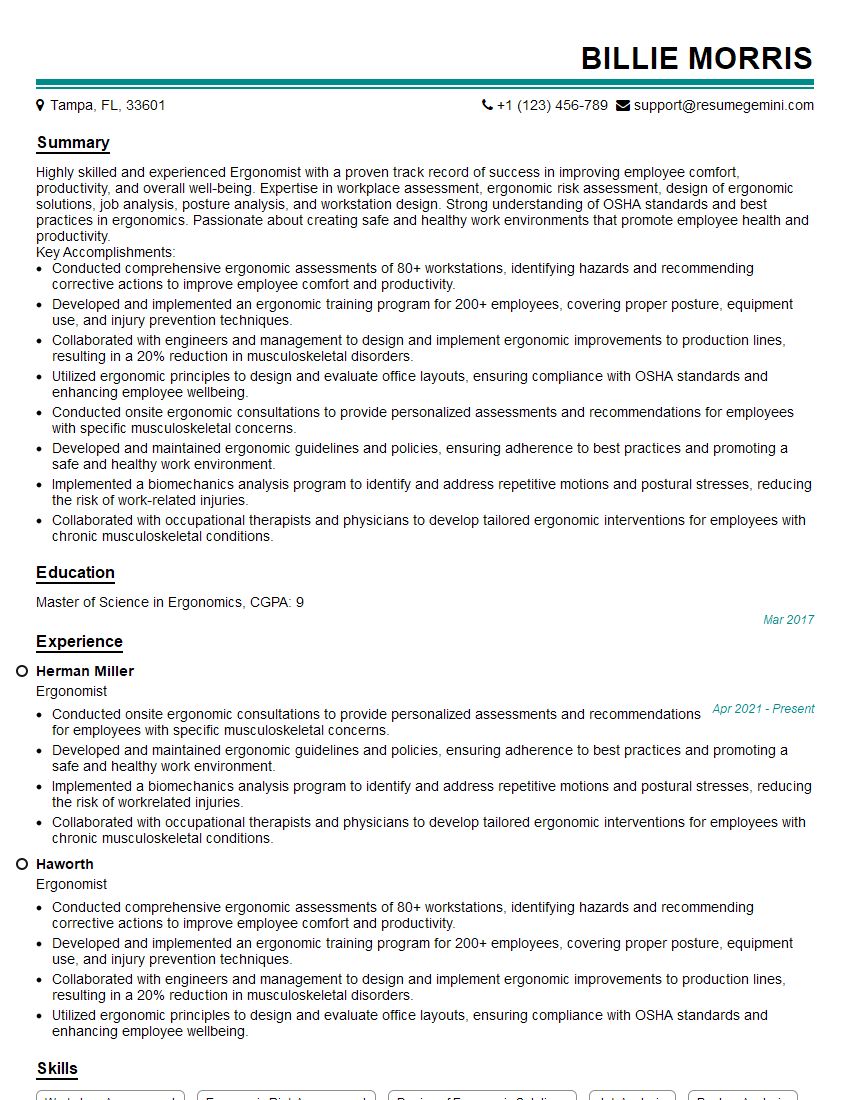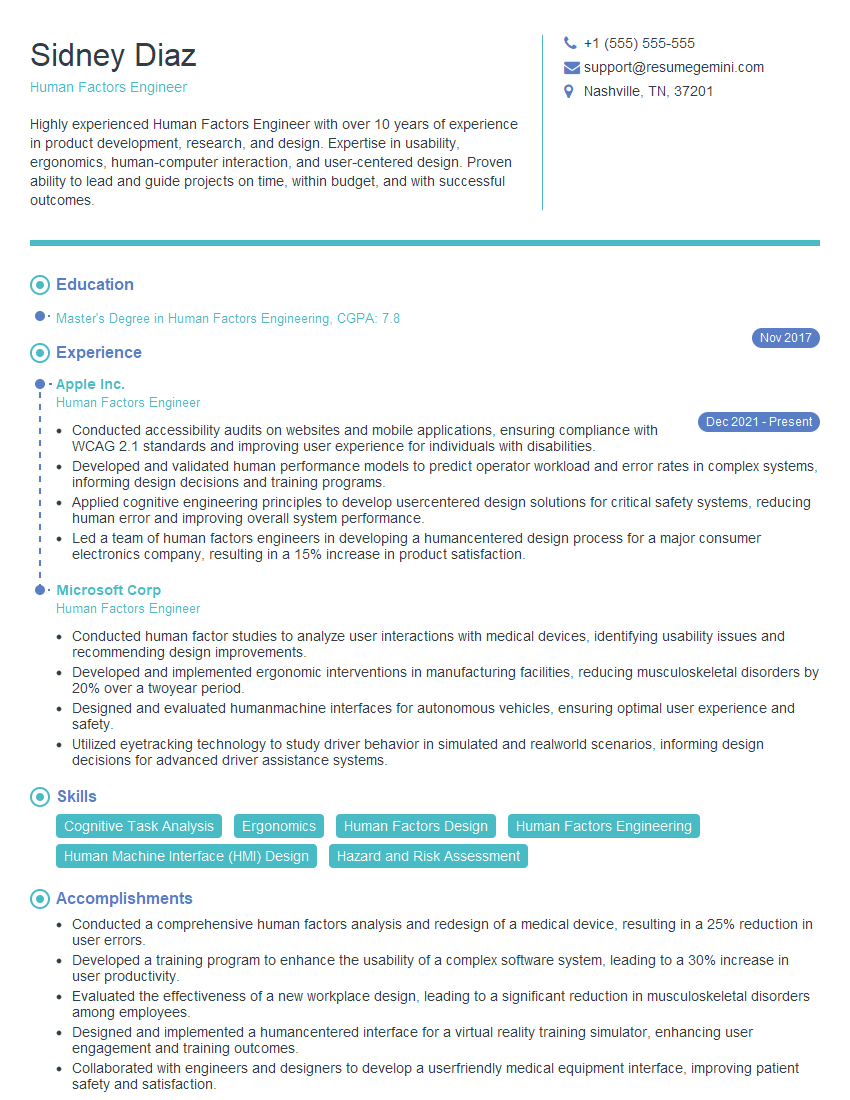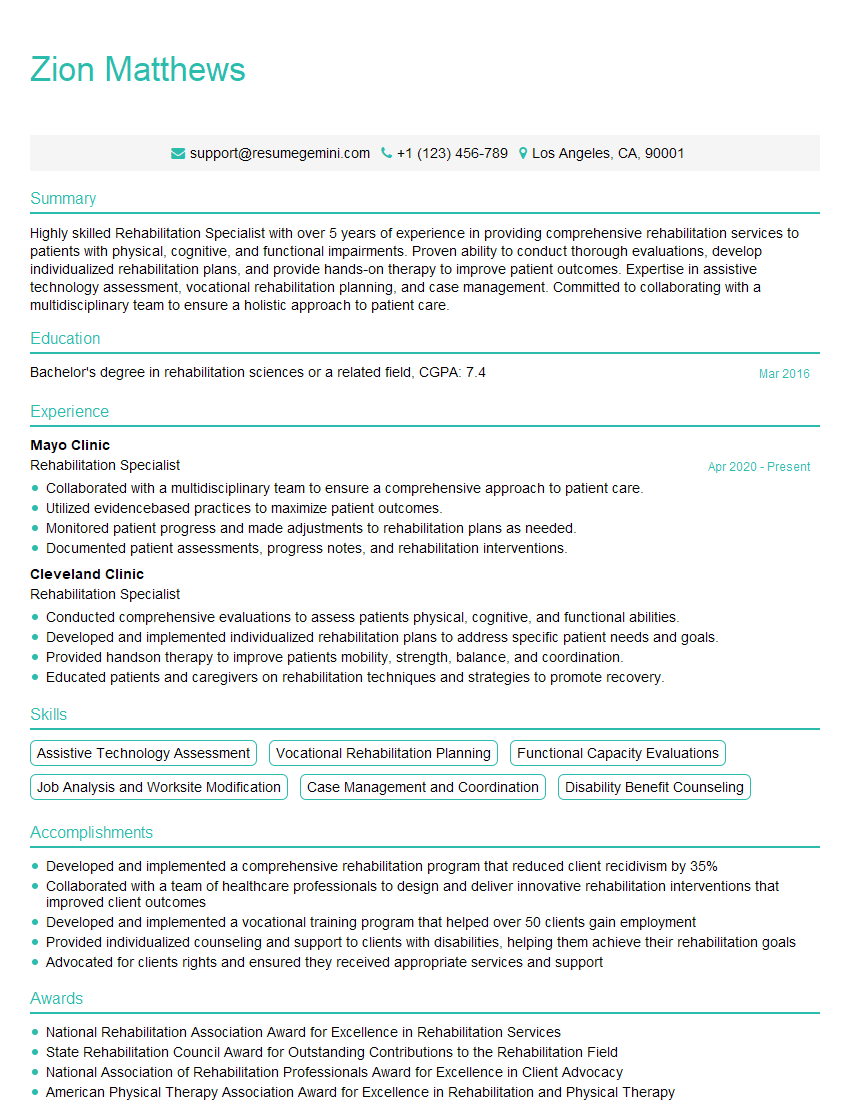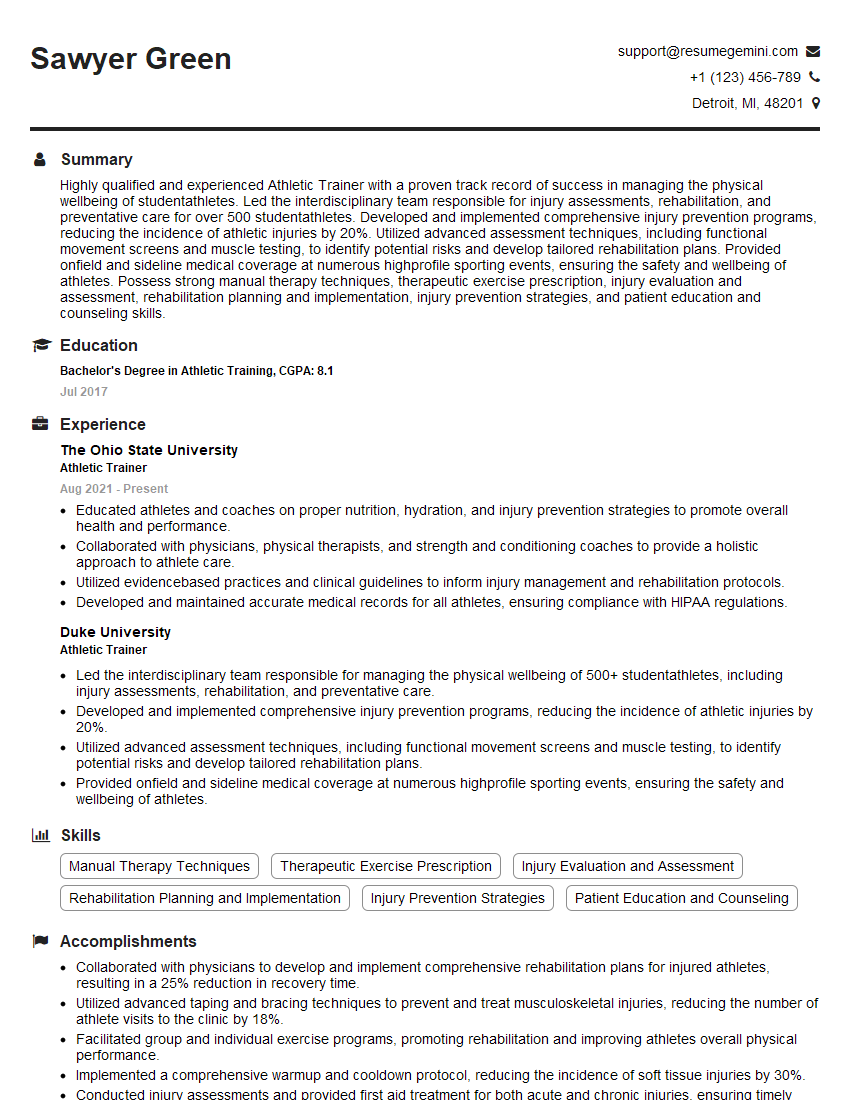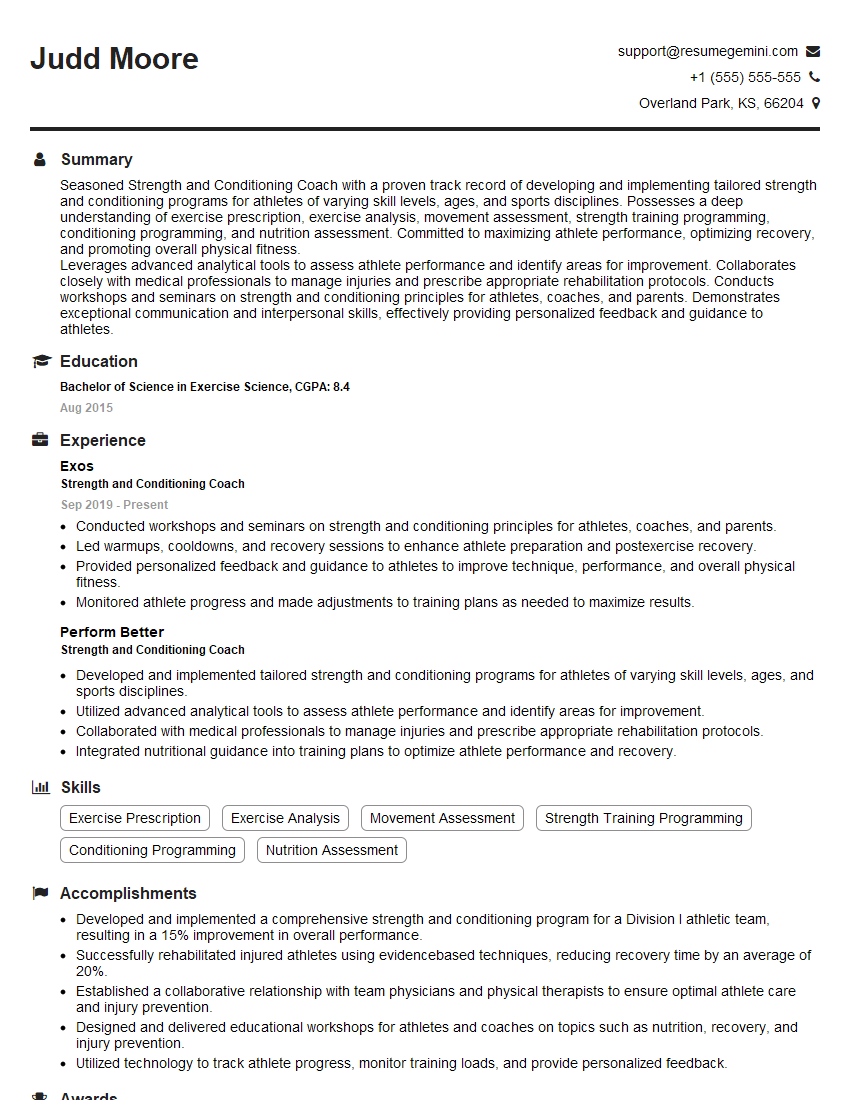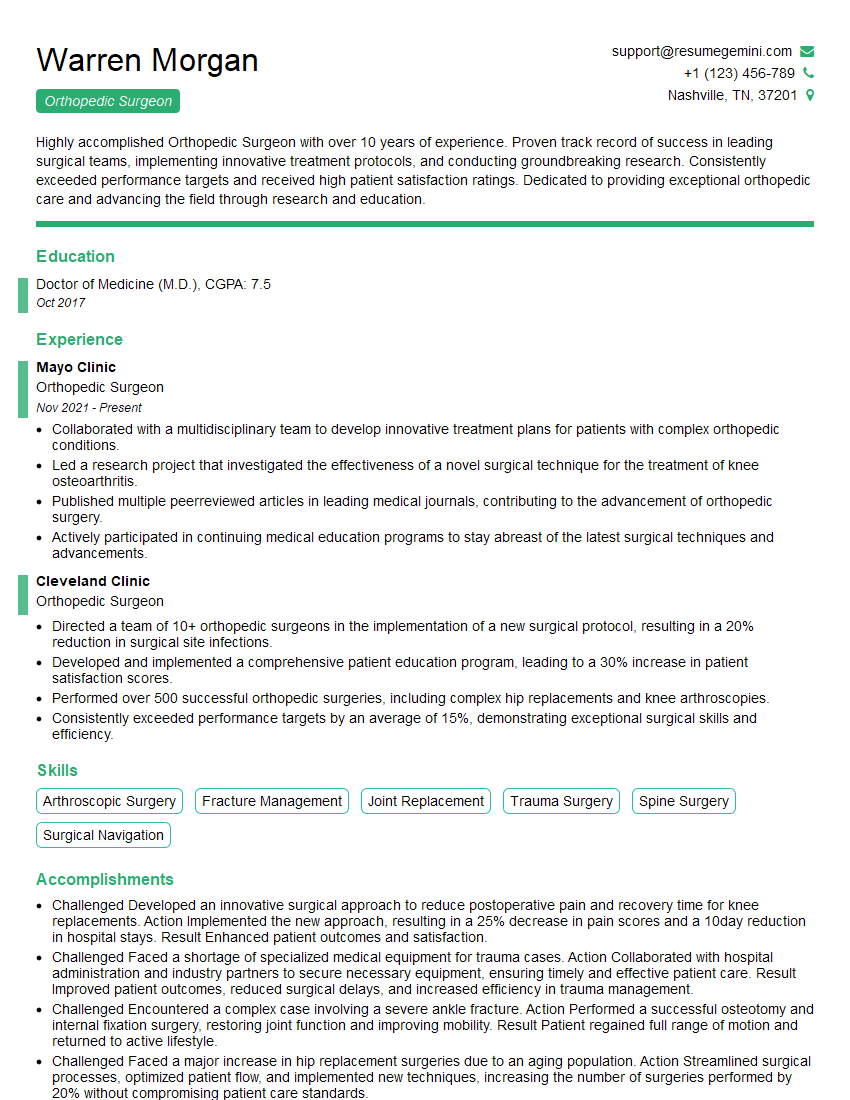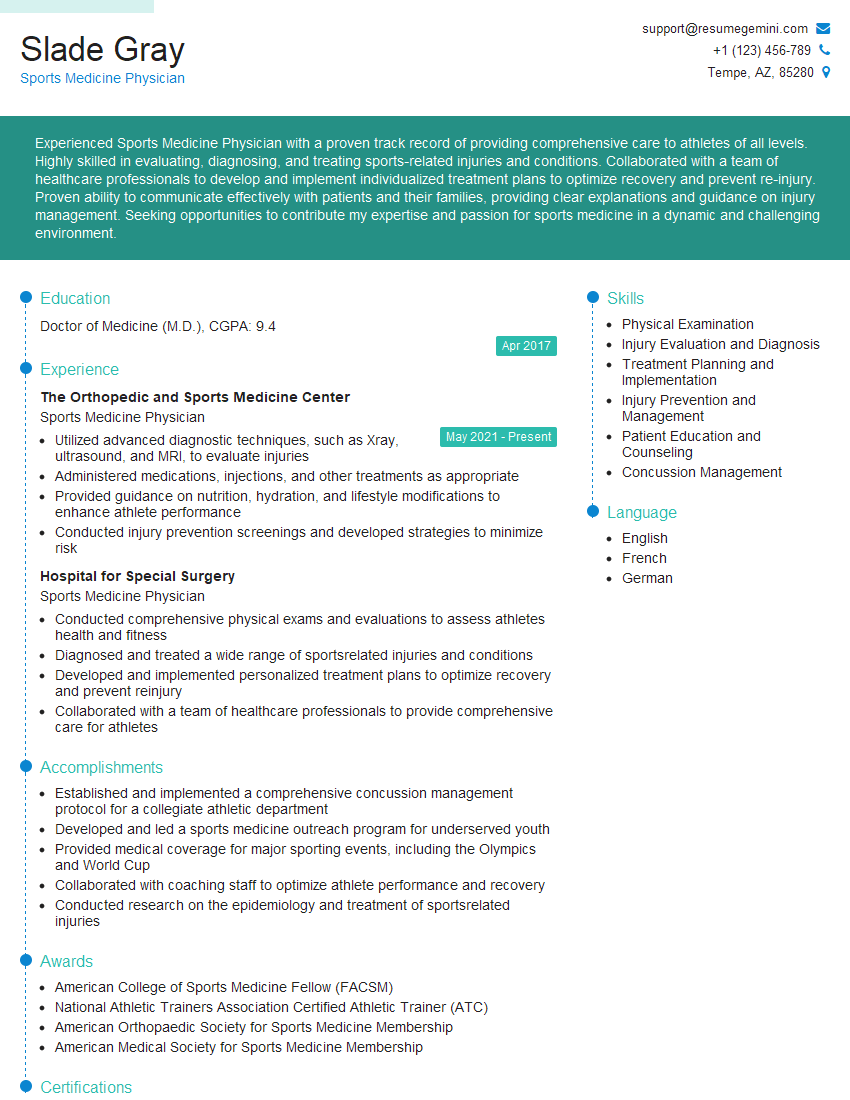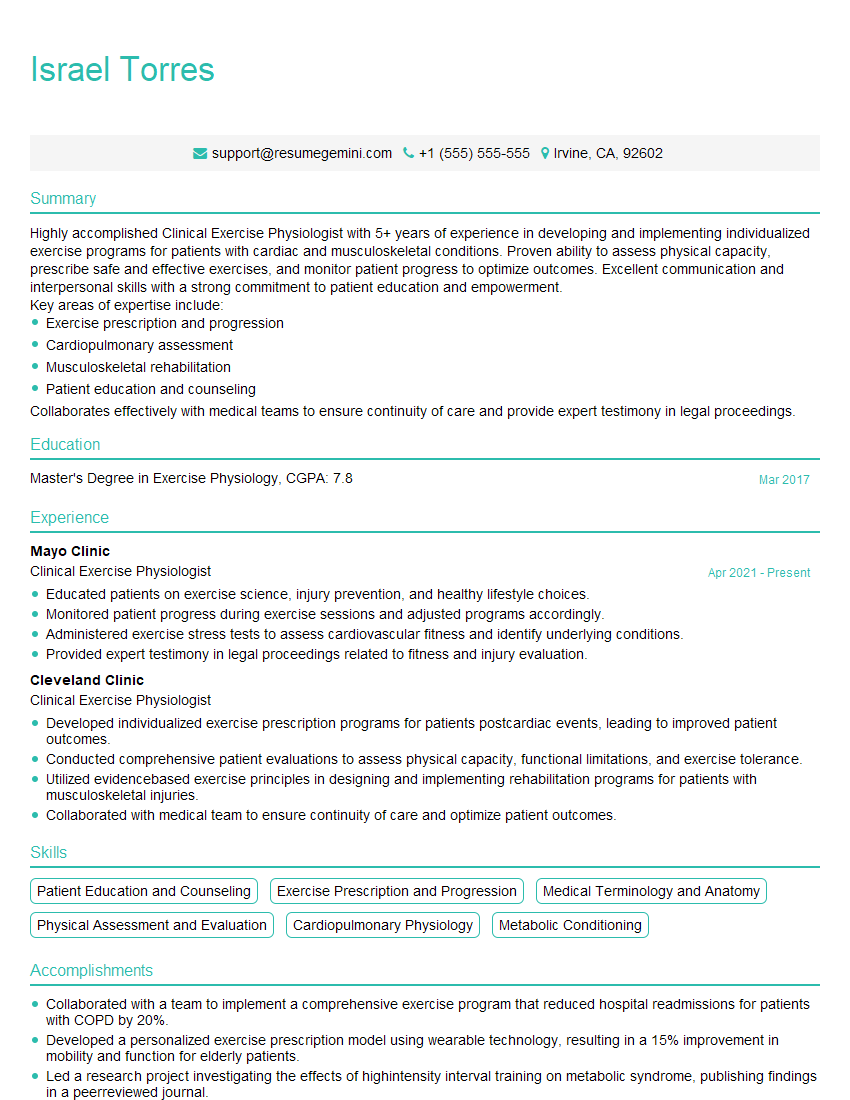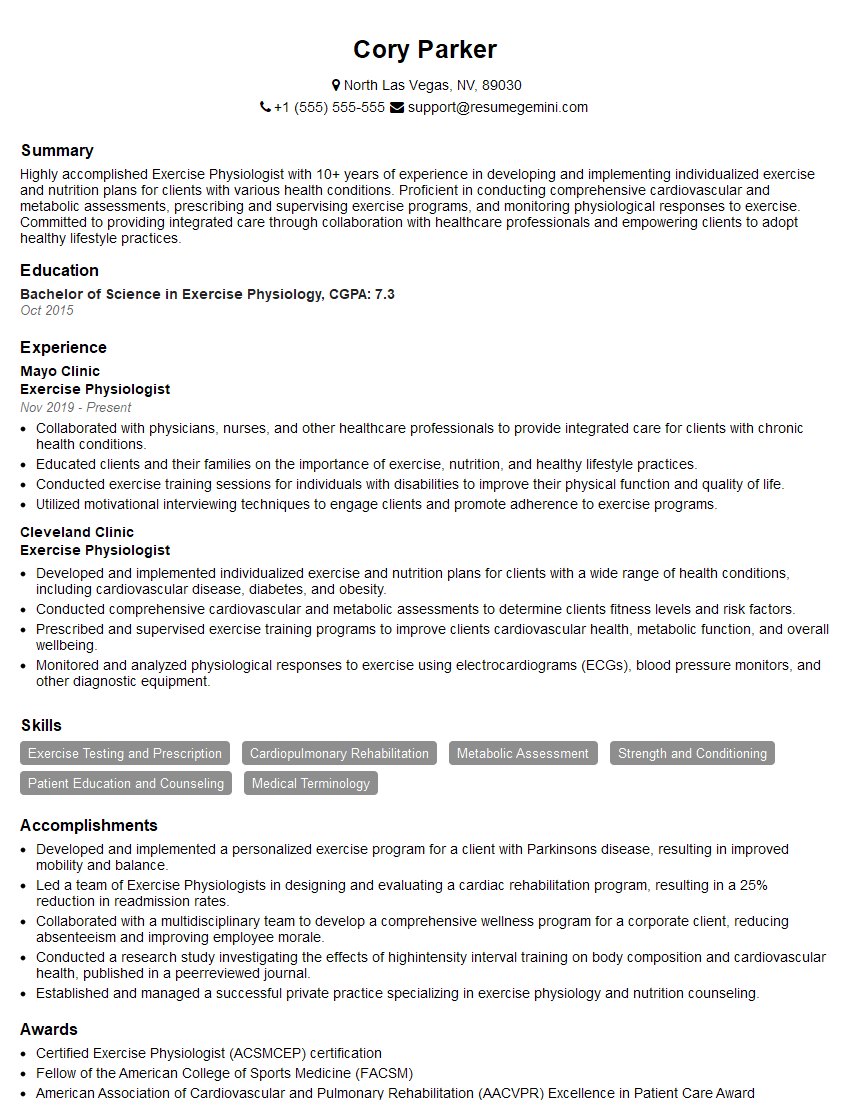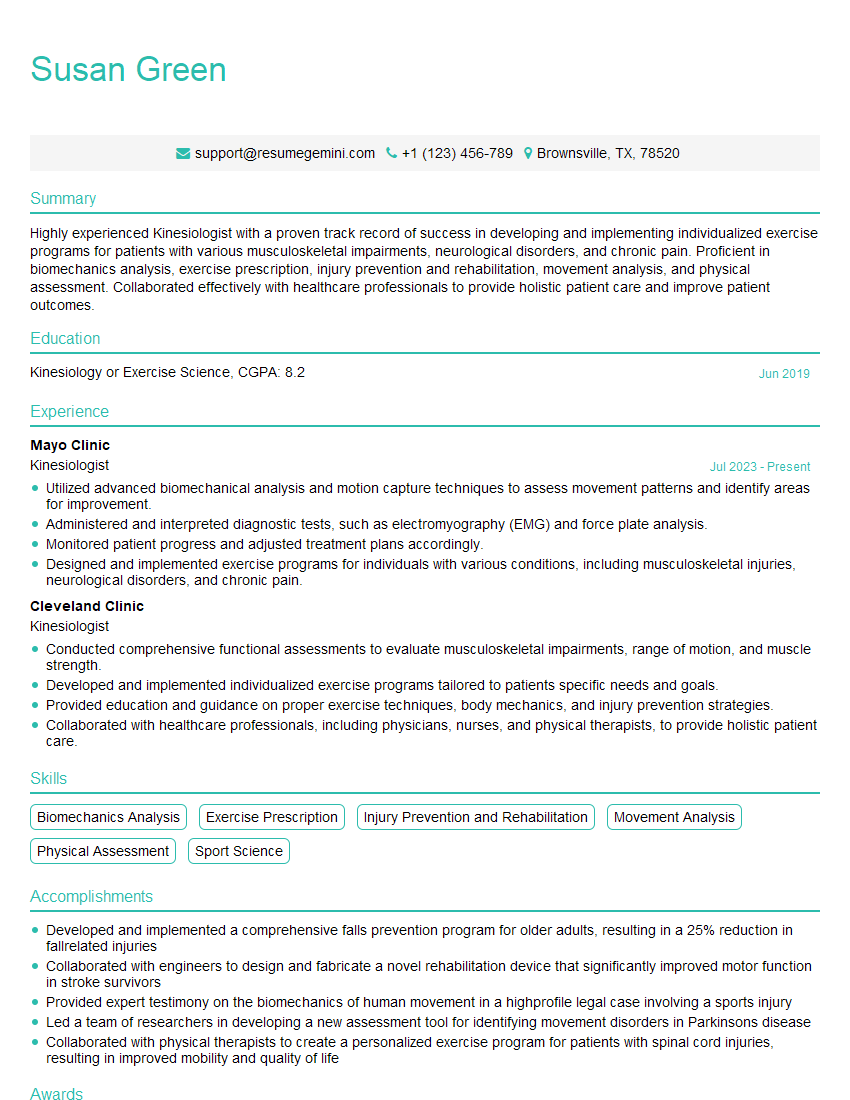Every successful interview starts with knowing what to expect. In this blog, we’ll take you through the top Muscle Mechanics interview questions, breaking them down with expert tips to help you deliver impactful answers. Step into your next interview fully prepared and ready to succeed.
Questions Asked in Muscle Mechanics Interview
Q 1. Explain the sliding filament theory of muscle contraction.
The sliding filament theory explains how muscles contract at a microscopic level. Imagine two sets of interdigitating filaments within a muscle fiber: thick filaments primarily composed of myosin, and thin filaments mainly containing actin. Muscle contraction occurs when these filaments slide past each other, shortening the sarcomere – the basic contractile unit of the muscle. This sliding is driven by the cyclical interaction between myosin heads and actin, fueled by ATP.
Think of it like two rows of oarsmen in a boat. Each myosin head is like an oar, grabbing onto the actin filament (the riverbank) and pulling. This coordinated pulling of many myosin heads causes the filaments to slide, shortening the overall length of the muscle fiber, much like the boat moves forward.
This process involves several key steps: ATP binding to myosin, hydrolysis of ATP causing a conformational change in myosin, cross-bridge formation between myosin and actin, power stroke (the pulling of actin), and detachment of myosin from actin. The cycle repeats as long as calcium ions and ATP are available.
Q 2. Describe the different types of muscle fibers and their characteristics.
Skeletal muscle fibers are categorized into different types based on their contractile and metabolic properties. These types are not mutually exclusive and there’s a spectrum, but generally, we talk about Type I, Type IIa, and Type IIx fibers.
- Type I (Slow-twitch oxidative): These fibers are slow to contract but highly resistant to fatigue. They rely heavily on oxidative metabolism (using oxygen) for energy production. Think of marathon runners; they have a high proportion of Type I fibers.
- Type IIa (Fast-twitch oxidative-glycolytic): These fibers contract faster than Type I and have moderate fatigue resistance. They use both oxidative and glycolytic (without oxygen) pathways for energy. Think of middle-distance runners; they have a good mix of Type I and Type IIa.
- Type IIx (Fast-twitch glycolytic): These fibers contract very rapidly but fatigue quickly. They primarily rely on glycolysis for energy. Think of sprinters; they predominantly have Type IIx fibers.
The distribution of these fiber types varies among individuals and is influenced by genetics and training.
Q 3. What are the factors affecting muscle force production?
Muscle force production is a complex process influenced by a number of factors:
- Number of motor units recruited: More motor units (groups of muscle fibers innervated by a single motor neuron) activated means greater force. Imagine lifting a feather versus a heavy weight; you recruit more motor units for the heavier weight.
- Frequency of stimulation: Higher stimulation frequencies lead to greater force through summation and tetanus. This is the rapid firing of motor neurons causing sustained contraction.
- Fiber type composition: Type II fibers generate more force than Type I fibers, but fatigue faster.
- Muscle length: The length of the muscle affects the overlap of actin and myosin filaments (explained further in the length-tension relationship).
- Muscle cross-sectional area: Larger muscles have more fibers and thus generate greater force.
- Fatigue: Prolonged activity leads to decreased force production due to depletion of energy stores and accumulation of metabolic byproducts.
Q 4. Explain the length-tension relationship in skeletal muscle.
The length-tension relationship describes the relationship between the resting length of a muscle and the force it can produce. At an optimal length, the muscle can generate maximal force. This is because there is optimal overlap between actin and myosin filaments; enough to allow for numerous cross-bridge interactions.
If the muscle is too short, the actin filaments overlap significantly, hindering cross-bridge formation. Conversely, if the muscle is too long, there is insufficient overlap between actin and myosin, reducing the number of cross-bridges that can form. Think of it like trying to row a boat. If the oars are too close together or too far apart, you won’t be able to row effectively.
The length-tension relationship is crucial for understanding muscle function in various movements and postures. For instance, it explains why we can lift heavier weights at some arm angles than others.
Q 5. Describe the force-velocity relationship in muscle contraction.
The force-velocity relationship illustrates the inverse relationship between the speed of muscle shortening (velocity) and the force it can produce. As the velocity of contraction increases, the force generated decreases. This is because at high speeds, there’s less time for cross-bridge cycling and power stroke completion.
Imagine trying to lift a heavy weight slowly versus quickly. You can lift a heavier weight slowly, but if you try to lift it quickly, you’ll need to lift a lighter weight. This is because at slower speeds, more cross bridges can form and contribute to force generation. Conversely, at higher speeds, there’s less time to form those cross-bridges effectively.
Understanding the force-velocity relationship is essential in sports training, rehabilitation, and designing assistive devices.
Q 6. What is the role of calcium in muscle contraction?
Calcium ions (Ca2+) play a crucial role in initiating muscle contraction. They act as a trigger, mediating the interaction between actin and myosin. In resting muscle, Ca2+ is stored in the sarcoplasmic reticulum (SR), a specialized intracellular calcium store.
Upon stimulation by a motor neuron, Ca2+ is released from the SR into the cytoplasm. This rise in cytoplasmic Ca2+ binds to troponin C, a protein on the thin filaments. This binding causes a conformational change in troponin, moving tropomyosin away from the myosin-binding sites on actin. This uncovers these sites and allows the myosin heads to bind and initiate the sliding filament process. Once the nerve impulse ceases, Ca2+ is actively pumped back into the SR, leading to muscle relaxation.
Q 7. Explain the role of ATP in muscle contraction.
Adenosine triphosphate (ATP) is the primary energy source for muscle contraction. It’s essential for several steps in the process:
- Myosin ATPase activity: ATP hydrolysis by the myosin head provides the energy for the conformational change that drives the power stroke (the pulling of actin).
- Cross-bridge detachment: ATP binding to the myosin head is necessary for detaching it from actin, allowing the cycle to repeat.
- Calcium pump: ATP is required to pump Ca2+ back into the sarcoplasmic reticulum, leading to muscle relaxation. Without this, the muscle would remain contracted.
The availability of ATP is critical for sustained muscle contraction. Depletion of ATP during intense exercise leads to muscle fatigue and inability to contract.
Q 8. Describe the different types of muscle contractions (isometric, concentric, eccentric).
Muscle contractions are the foundation of movement. We categorize them into three main types: isometric, concentric, and eccentric.
- Isometric contractions occur when muscle length remains constant while force is generated. Think of holding a heavy weight in place – your muscles are working hard, but they aren’t shortening or lengthening. This type of contraction is crucial for maintaining posture and stabilizing joints.
- Concentric contractions involve muscle shortening while producing force. Lifting a weight is a prime example; your biceps contract and shorten to bring the weight towards your shoulder. This is the type of contraction most people associate with strength training.
- Eccentric contractions happen when a muscle lengthens while generating force. Lowering a weight slowly is a perfect illustration. Your biceps are still working to control the movement, preventing the weight from dropping uncontrollably, even though they are lengthening. Eccentric contractions are important for injury prevention and building muscle endurance.
Understanding these different contraction types is vital for designing effective exercise programs, rehabilitating injuries, and analyzing movement patterns in sports and everyday activities.
Q 9. What are the neuromuscular junctions and their significance?
Neuromuscular junctions (NMJs) are the specialized synapses between a motor neuron and a muscle fiber. They’re the crucial communication points where nerve impulses trigger muscle contractions.
A motor neuron releases a neurotransmitter called acetylcholine (ACh) into the synaptic cleft, the gap between the nerve and muscle. ACh binds to receptors on the muscle fiber’s membrane, causing depolarization and triggering a cascade of events leading to muscle fiber contraction. This process ensures precise control over muscle activity.
The significance of NMJs is immense. Disruptions in NMJ function, such as those seen in conditions like myasthenia gravis (an autoimmune disease attacking ACh receptors), can severely impair muscle strength and function. Understanding NMJs is essential for diagnosing and treating neuromuscular disorders.
Q 10. Explain the concept of muscle fatigue.
Muscle fatigue is a decline in muscle force or power output during prolonged or intense activity. It’s a complex phenomenon with multiple contributing factors.
- Peripheral fatigue originates within the muscle itself. It can involve depletion of energy stores (like glycogen), accumulation of metabolic byproducts (like lactic acid), and changes in ion concentrations within muscle cells, all impacting the contractile proteins’ ability to function effectively.
- Central fatigue refers to changes in the central nervous system that reduce the signal sent to the muscles. This might involve decreased motor neuron excitability or reduced motivation.
Muscle fatigue is not simply ‘tiredness’; it involves physiological changes that can limit performance. Understanding these mechanisms allows for development of strategies to improve training and prevent overtraining, crucial in athletic performance and rehabilitation.
Q 11. Describe the different methods for measuring muscle force and activity (EMG, dynamometry).
We use various methods to measure muscle force and activity. Two common techniques are electromyography (EMG) and dynamometry.
- Electromyography (EMG) measures the electrical activity produced by muscles. Small electrodes, placed on the skin’s surface (surface EMG) or inserted directly into the muscle (needle EMG), detect the electrical signals generated during muscle contraction. This gives information about the timing and intensity of muscle activation, not just the overall force produced.
- Dynamometry measures the force or torque produced by a muscle or muscle group. Isometric dynamometers measure the maximal force a muscle can exert without changing length. Isokinetic dynamometers measure force during movement at a constant speed. Dynamometers provide a direct measure of muscle strength.
Both EMG and dynamometry are valuable tools in research, clinical settings (rehabilitation, diagnostics), and sports science, providing insights into muscle function and performance.
Q 12. Explain the biomechanics of walking.
Walking is a complex rhythmic pattern of alternating limb movements. Biomechanically, it involves a series of phases:
- Stance phase: The foot is in contact with the ground. This phase includes heel strike, midstance, and toe-off.
- Swing phase: The foot is off the ground, moving forward to prepare for the next stance phase.
Muscles in the legs and hips work together, generating forces to propel the body forward and maintain balance. The gait cycle exhibits distinct patterns of joint angles and muscle activation. Analysis of walking gait is important for diagnosing and treating gait disorders.
Q 13. Explain the biomechanics of running.
Running shares similarities with walking but involves a flight phase where both feet are off the ground. The biomechanics are significantly different from walking due to the increased speed and impact forces.
Key aspects include a shorter stance phase and a longer flight phase compared to walking. Muscle activation patterns are more intense, particularly in the leg extensors during push-off. Foot strike patterns (rearfoot, midfoot, forefoot) influence joint loading and injury risk.
Analyzing running biomechanics helps optimize running efficiency, reduce injury risk, and improve athletic performance. Factors like stride length, cadence, and ground reaction forces are all crucial to consider.
Q 14. Describe the biomechanics of jumping.
Jumping involves a powerful concentric contraction of leg muscles to propel the body upwards. The biomechanics are based on principles of impulse and momentum.
The process starts with a countermovement (often a slight downward movement), which helps utilize elastic energy stored in the muscles and tendons. Then, a forceful concentric contraction of the leg muscles (primarily quadriceps, hamstrings, and gluteals) generates a large vertical impulse, creating the upward momentum required for the jump.
Factors like jump height, take-off velocity, and joint angles all influence jump performance. Biomechanical analysis of jumping helps improve techniques in sports like basketball, volleyball, and high jump.
Q 15. How do you analyze muscle movement using motion capture technology?
Motion capture technology allows us to analyze muscle movement with remarkable precision. We use markers placed on the skin, reflecting infrared light emitted by cameras. These cameras record the three-dimensional coordinates of the markers at high speed. Sophisticated software then tracks marker movement, reconstructing the underlying skeletal and muscle motion.
The data gives us detailed information about joint angles, velocities, and accelerations. This information is then used to create models of muscle activation and force production during movement. For example, we might analyze a baseball pitcher’s throwing motion to identify optimal joint angles for maximum velocity, or study a runner’s gait to identify areas for improvement in efficiency. The process often involves biomechanical modeling, combining the motion capture data with anatomical information and muscle models to simulate and understand muscle behaviour.
Beyond simple movements, techniques like electromyography (EMG) are often combined with motion capture. EMG measures the electrical activity of muscles providing insight into when and how strongly different muscles are activated during a given movement. This combined approach provides a much more holistic understanding of the complex interplay of muscles involved in any movement.
Career Expert Tips:
- Ace those interviews! Prepare effectively by reviewing the Top 50 Most Common Interview Questions on ResumeGemini.
- Navigate your job search with confidence! Explore a wide range of Career Tips on ResumeGemini. Learn about common challenges and recommendations to overcome them.
- Craft the perfect resume! Master the Art of Resume Writing with ResumeGemini’s guide. Showcase your unique qualifications and achievements effectively.
- Don’t miss out on holiday savings! Build your dream resume with ResumeGemini’s ATS optimized templates.
Q 16. What are the common musculoskeletal injuries and their causes?
Common musculoskeletal injuries are widespread and impact individuals across various age groups and activity levels. Causes are multifaceted, frequently stemming from a combination of factors.
- Muscle Strains: These occur when muscles or tendons are overstretched or torn, often due to sudden movements, overuse, or inadequate warm-up. Think of a sprinter pulling a hamstring.
- Ligament Sprains: These involve injuries to ligaments, the connective tissues connecting bones. Ankle sprains are common, often resulting from twisting or rolling the ankle.
- Tendinitis: Inflammation of tendons, often caused by repetitive movements or overuse. Tennis elbow, affecting the tendons in the forearm, is a prime example.
- Bursitis: Inflammation of bursae, fluid-filled sacs that cushion joints. Repetitive movements or direct trauma can lead to this condition.
- Fractures: Bone breaks caused by high-impact forces. Falls and sports injuries are frequent causes.
- Carpal Tunnel Syndrome: Compression of the median nerve in the wrist, often related to repetitive hand movements or certain occupations.
Prevention strategies generally focus on proper training techniques, adequate warm-up and cool-down periods, appropriate use of protective equipment, and ergonomic considerations for work and daily activities.
Q 17. Explain the principles of muscle rehabilitation.
Muscle rehabilitation aims to restore muscle function following injury or surgery. The principles are centered around a progressive and individualized approach.
- Inflammation Management: Initially, the focus is on reducing pain and inflammation through rest, ice, compression, and elevation (RICE).
- Range of Motion (ROM) Exercises: Gentle movements help maintain joint flexibility and prevent stiffness.
- Strengthening Exercises: Gradually increase muscle strength using exercises tailored to the specific muscle group and injury. This often begins with isometric exercises (no movement) and progresses to isotonic exercises (movement through a range of motion).
- Endurance Training: Improve muscle endurance to support functional activities.
- Neuromuscular Re-education: Retraining the brain and muscles to work together effectively, improving coordination and motor control.
- Functional Training: Focus on activities related to daily life, gradually increasing the difficulty to improve overall functionality.
The rehabilitation process is closely monitored, adapting the plan based on the patient’s progress and response. Patient education and motivation are crucial for success.
Q 18. What are the ethical considerations in muscle mechanics research?
Ethical considerations in muscle mechanics research are paramount, ensuring the well-being and rights of participants are protected. Key areas include:
- Informed Consent: Participants must fully understand the study’s purpose, procedures, potential risks and benefits, and their right to withdraw at any time.
- Minimizing Risks: Research protocols must minimize physical and psychological harm. This includes carefully designing experiments, using appropriate safety measures, and having trained personnel overseeing procedures.
- Data Privacy and Confidentiality: Participants’ identities and data must be protected through secure storage and anonymization techniques.
- Equity and Inclusion: Research designs should strive for diversity in participants, avoiding biases that might exclude certain populations.
- Transparency and Publication: Results should be accurately reported, regardless of whether they support initial hypotheses. Ethical research practices require openness and honesty.
- Animal Research Ethics: If animal models are used, rigorous ethical review processes must be followed, prioritizing humane treatment and minimizing distress.
Ethical review boards (IRBs) play a vital role in ensuring adherence to ethical guidelines. Researchers must rigorously adhere to established standards and guidelines.
Q 19. Describe the different types of muscle models (Hill-type, cross-bridge models).
Muscle models help us understand muscle mechanics. They range in complexity, from simple representations to highly detailed simulations.
- Hill-type models: These are relatively simple, representing the muscle as a system of contractile, elastic, and viscous components. The contractile element generates force, while the elastic elements store energy and provide passive tension. The viscous component represents the internal friction within the muscle. This model captures the basic mechanical behavior of the muscle, such as force-velocity and force-length relationships. It’s relatively easy to use and has been widely applied in many situations.
- Cross-bridge models: These models delve into the molecular level, simulating the interaction between actin and myosin filaments during muscle contraction. They incorporate the biochemistry of muscle contraction, providing a more detailed and physiologically accurate representation. However, they are computationally more demanding and require advanced knowledge of muscle physiology.
Choosing a model depends on the research question. If a simple representation of muscle mechanics is adequate, a Hill-type model may suffice. For deeper insights into the underlying mechanisms, a cross-bridge model might be necessary.
Q 20. How do you assess muscle strength and endurance?
Assessing muscle strength and endurance involves a combination of methods, providing a comprehensive evaluation.
- Strength Assessment: This typically involves measuring the maximal force a muscle or muscle group can generate. Common methods include:
- Isometric tests: Measuring force while maintaining a constant muscle length (e.g., handgrip dynamometry).
- Isokinetic tests: Measuring force at a constant velocity (e.g., specialized dynamometers).
- Isotonic tests: Measuring force while the muscle length changes (e.g., weightlifting exercises).
- Endurance Assessment: This focuses on a muscle’s ability to sustain repeated contractions or maintain force over time. Common methods include:
- Repetitive contractions: Performing a specific exercise repeatedly until fatigue occurs.
- Time-to-fatigue tests: Maintaining a specific force or performing an exercise until muscle fatigue sets in.
The choice of assessment methods depends on the specific muscle or muscle group, the research question, and available equipment.
Q 21. Explain the concept of muscle plasticity.
Muscle plasticity refers to the remarkable ability of muscles to adapt their structure and function in response to changes in their environment. This adaptation can manifest in different ways:
- Hypertrophy: Increase in muscle fiber size, leading to increased strength. This typically occurs in response to strength training.
- Hyperplasia: Increase in the number of muscle fibers, contributing to greater muscle mass. The role of hyperplasia in adult muscle growth is still being actively investigated.
- Atrophy: Decrease in muscle fiber size and strength, often resulting from inactivity, injury, or disease.
- Metabolic changes: Alterations in the muscle’s energy metabolism, affecting its ability to produce ATP and sustain activity.
- Fiber type shifts: Changes in the proportion of different muscle fiber types (e.g., fast-twitch vs. slow-twitch) in response to training or inactivity.
Understanding muscle plasticity is essential for optimizing training programs, designing effective rehabilitation strategies, and managing muscle-related disorders. The principles of muscle plasticity underpin the effectiveness of exercise interventions aimed at improving muscle function, strength, and endurance.
Q 22. What is the impact of aging on muscle function?
Aging significantly impacts muscle function, leading to a phenomenon known as sarcopenia – age-related loss of muscle mass and strength. This decline isn’t uniform across all muscle types or individuals. Several factors contribute:
- Decreased protein synthesis: The body’s ability to build and repair muscle protein slows down, resulting in a net loss of muscle tissue.
- Increased muscle fiber atrophy: Individual muscle fibers shrink in size, reducing overall strength and power.
- Changes in muscle fiber type: A shift occurs towards a higher proportion of type II (fast-twitch) fibers being replaced by type I (slow-twitch) fibers, impacting power and speed.
- Reduced neuromuscular efficiency: The communication between the nervous system and muscles becomes less effective, leading to weaker contractions.
- Hormonal changes: Reduced levels of testosterone and growth hormone further contribute to muscle loss.
The impact is seen in reduced physical performance, increased risk of falls and fractures, and decreased overall quality of life. Regular exercise, particularly resistance training, and a balanced diet rich in protein are crucial for mitigating these age-related changes. Think of it like this: your muscles are like a garden; if you don’t consistently tend to them with exercise and proper nutrition, they’ll begin to wither.
Q 23. What is the role of muscle mechanics in sports performance?
Muscle mechanics are fundamental to sports performance. Understanding how muscles generate force, power, and velocity is crucial for optimizing training and technique. For example:
- Force production: The ability to generate maximal force is crucial in strength-based sports like weightlifting. This involves factors like muscle fiber type distribution, muscle cross-sectional area, and motor unit recruitment.
- Power output: Explosive power, vital in sports like sprinting or jumping, relies on the rate of force development. Training programs often focus on plyometrics and high-intensity interval training to improve this.
- Movement speed and agility: The speed of muscle contraction and relaxation dictates agility and speed. Training methods like speed drills improve the speed-strength relationship.
- Muscle coordination and timing: Efficient movement requires precise coordination between multiple muscle groups. This is crucial for sports requiring complex movements, such as gymnastics or tennis.
Analyzing an athlete’s muscle mechanics, through methods like electromyography (EMG) and motion capture, can identify areas for improvement in training or technique. For example, identifying inefficient muscle activation patterns can lead to targeted interventions to optimize performance and reduce injury risk.
Q 24. How do you design a rehabilitation program for muscle injuries?
Designing a rehabilitation program for muscle injuries requires a systematic approach focused on restoring muscle function and preventing re-injury. The program typically involves:
- Initial assessment: This includes determining the extent of the injury, assessing pain levels, and evaluating range of motion and muscle strength.
- Inflammation management: Early stages often involve rest, ice, compression, and elevation (RICE) to reduce swelling and pain.
- Range of motion exercises: Gentle exercises are introduced to restore joint mobility and prevent stiffness.
- Progressive strengthening: Gradually increasing resistance and intensity to rebuild muscle strength and endurance. This might start with isometric exercises (static contractions) and progress to isotonic exercises (dynamic contractions).
- Neuromuscular re-education: Exercises focusing on improving motor control and coordination are included to optimize muscle recruitment patterns and prevent compensation.
- Functional exercises: Activities that mimic real-life movements are implemented to ensure successful return to daily activities and sport.
- Return to activity: A gradual and monitored return to normal activity, ensuring the injured muscle can tolerate increasing stress.
The program should be tailored to the individual, considering factors like injury severity, age, fitness level, and overall health. Regular monitoring and adjustments are crucial for optimal recovery. Imagine rebuilding a broken vase; you need a careful and measured approach to ensure its functionality is fully restored.
Q 25. Explain the application of muscle mechanics in ergonomics.
Ergonomics focuses on designing workplaces and tasks to minimize physical stress and strain. Muscle mechanics play a vital role in understanding and preventing musculoskeletal disorders (MSDs). By analyzing the forces and stresses on muscles during various tasks, we can optimize work environments and tools.
- Posture analysis: Understanding how posture affects muscle loading can help design workstations that promote neutral posture and reduce muscle strain. For example, adjusting chair height and monitor placement to reduce neck and back strain.
- Tool design: Ergonomic tool design aims to minimize muscle exertion and reduce awkward postures. Examples include power tools that reduce hand fatigue, or handles designed to fit the hand comfortably.
- Workstation design: Designing workstations to accommodate natural movement patterns, and avoid prolonged static postures, reduces muscle fatigue and strain.
- Material handling: Analyzing lifting techniques and optimizing the weight and position of loads can minimize back injuries.
By applying principles of muscle mechanics, we can create safer and more efficient work environments, reducing the incidence of MSDs and boosting worker productivity and well-being. It’s about creating a harmonious relationship between the worker and their environment, making the work less taxing on the body.
Q 26. Describe the use of finite element analysis in muscle mechanics.
Finite element analysis (FEA) is a powerful computational technique used to model and analyze the mechanical behavior of muscles. It involves dividing the muscle into a mesh of small elements, each with defined material properties and boundary conditions. This allows us to simulate muscle contraction, deformation, and stress distribution under various loading conditions.
FEA can be used to:
- Predict muscle force and stress: Determine the forces generated by muscles during different movements and identify areas of high stress that might predispose to injury.
- Analyze muscle architecture: Investigate the effects of muscle fiber arrangement and pennation angle on force production and efficiency.
- Study muscle-tendon interactions: Model the forces transmitted between muscle and tendon, providing insights into tendon loading and injury mechanisms.
- Design and test implants: Evaluate the biomechanical interactions of muscle tissue with artificial implants, such as prosthetics or surgical devices.
Example: A FEA model could simulate the stresses on a quadriceps muscle during a squat, providing information on the force generated by different muscle fiber types and the stress distribution across the muscle and patellar tendon. This information is invaluable for understanding the injury mechanisms during this exercise and for designing targeted rehabilitation strategies.
Q 27. What are the latest advancements in muscle mechanics research?
Recent advancements in muscle mechanics research are driven by advancements in imaging techniques and computational modeling. Key areas include:
- Advanced imaging techniques: High-resolution MRI and ultrasound are providing detailed information about muscle architecture, fiber orientation, and changes in muscle structure during contraction. This allows for more accurate models in FEA.
- Computational modeling: Improvements in computational power and model sophistication are allowing for increasingly realistic simulations of muscle behavior. This includes incorporating more detailed material properties and considering the complex interactions between muscle fibers, connective tissue, and tendons.
- Muscle plasticity and adaptation: Research is focusing on how muscles adapt to training and injury, with a focus on understanding the underlying molecular and cellular mechanisms. This knowledge is crucial for designing effective training programs and rehabilitation strategies.
- Multiscale modeling: Combining models at different scales, from molecular to whole-muscle, is allowing for a more holistic understanding of muscle function and mechanics. This is important for studying issues like muscle fatigue and age-related decline.
- Artificial muscle research: Developing artificial muscles using materials like polymers and carbon nanotubes is an exciting area with potential applications in robotics and biomedical engineering.
These advancements are leading to a deeper understanding of muscle function and its role in health and disease, paving the way for improved therapies for muscle injuries and age-related muscle loss.
Q 28. How do you interpret electromyography (EMG) data?
Electromyography (EMG) measures the electrical activity of muscles. Interpreting EMG data involves analyzing the amplitude, frequency, and timing of these signals to understand muscle activation patterns.
- Amplitude: The amplitude of the EMG signal reflects the level of muscle activation. Higher amplitudes generally indicate stronger muscle contractions.
- Frequency: The frequency of the signal provides information about the rate of motor unit firing. Higher frequencies typically reflect faster muscle contractions.
- Timing: Analyzing the onset, duration, and offset of EMG activity reveals the timing of muscle activation relative to movement. This is crucial for identifying co-contractions or delays in muscle activation that can indicate neuromuscular impairments.
EMG data is often used in conjunction with other biomechanical measurements (e.g., force, movement kinematics) to provide a comprehensive understanding of muscle function during movement. For example, comparing EMG activity of the biceps and triceps during elbow flexion can reveal the extent of activation of each muscle and the efficiency of the movement. Abnormal activation patterns may indicate muscle weakness, injury, or neurological problems. Careful consideration of the experimental setup, electrode placement, and signal processing techniques are essential for accurate and reliable interpretation of EMG data.
Key Topics to Learn for Muscle Mechanics Interview
- Muscle Fiber Types and Their Properties: Understand the differences between Type I, Type IIa, and Type IIx fibers, including their contractile speed, fatigue resistance, and metabolic characteristics. Consider how these properties relate to different athletic activities and training methodologies.
- Muscle Contraction Mechanisms: Master the sliding filament theory, including the roles of actin, myosin, ATP, and calcium ions. Be prepared to discuss the different types of muscle contractions (isometric, concentric, eccentric) and their implications for force production and muscle damage.
- Neuromuscular Junction and Motor Unit Recruitment: Explain the process of neuromuscular transmission and how motor unit recruitment influences force generation and muscle coordination. Consider scenarios where this process might be impaired.
- Muscle Force-Length and Force-Velocity Relationships: Understand how the length of a muscle and the speed of contraction affect the force it can produce. Be able to apply this knowledge to practical situations like designing exercise programs or analyzing athletic performance.
- Biomechanics of Movement: Analyze how muscles work together to produce movement at joints. Understand concepts like levers, torque, and angular momentum, and their relevance to human movement. Consider how muscle imbalances can lead to injuries.
- Muscle Growth and Adaptation: Discuss the mechanisms of muscle hypertrophy and hyperplasia in response to training. Understand the role of hormones and other factors in muscle growth and adaptation.
- Muscle Injuries and Rehabilitation: Familiarize yourself with common muscle injuries (strains, tears, etc.) and their treatment and rehabilitation strategies. This demonstrates a holistic understanding of muscle mechanics.
Next Steps
Mastering Muscle Mechanics is crucial for career advancement in various fields, from sports science and physical therapy to biomechanics and exercise physiology. A strong understanding of these principles showcases your expertise and problem-solving abilities to potential employers. To maximize your job prospects, creating an ATS-friendly resume is vital. ResumeGemini is a trusted resource that can help you build a professional resume that highlights your skills and experience effectively. Examples of resumes tailored to Muscle Mechanics roles are available to help you craft the perfect application.
Explore more articles
Users Rating of Our Blogs
Share Your Experience
We value your feedback! Please rate our content and share your thoughts (optional).
What Readers Say About Our Blog
good
